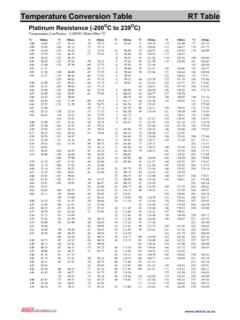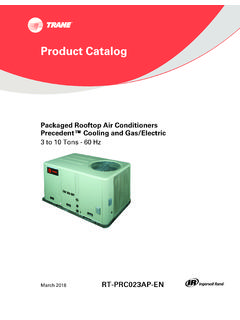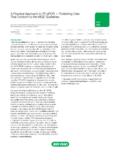Transcription of Separation and Purification of Hydrogen
1 UNESCO EOLSSSAMPLE CHAPTERSENERGY CARRIERS AND conversion SYSTEMS Vol. I - Separation and Purification of Hydrogen - Itsuki Uehara Encyclopedia of Life Support Systems(EOLSS) Separation AND Purification OF Hydrogen Itsuki Uehara National Institute of Advanced Industrial Science and Technology, Japan Keywords: Partial condensation, Absorption Separation , Adsorption Separation , Pressure swing adsorption, Metal Hydrides, Palladium membrane processes, Polymer membrane processes, Membrane Separation . Contents 1. Introduction 2. Partial Condensation 3. Absorption Methods Physical Absorption Processes Chemical Absorption Processes 4. Adsorption Methods Adsorption Processes Pressure Swing Adsorption Processes 5. Membrane Separation Polymer Membrane Processes Palladium Membrane Processes 6. Separation by Metal Hydrides Glossary Bibliography Biographical Sketch Summary A variety of methods to separate and purify Hydrogen exist.
2 The processes in the removal of impurities from crude Hydrogen to obtain a pure product can be roughly divided into three steps. The first step is pretreatment of the crude Hydrogen for the removal of specific contaminants that are detrimental to subsequent Separation processes and for their conversion to easily separable species. Three methods of conventional adsorption, physical absorption and chemical reactions are effective for these purposes. The second step is the removal of both major and minor impurities to yield an acceptably pure Hydrogen level. The prime Separation technology here is the pressure swing adsorption (PSA) unit, which has several advantages over the other methods and is widely used in various fields of Hydrogen Separation . Physical absorption and polymer membrane processes are also applicable to Hydrogen recovery from crude Hydrogen mixed with hydrocarbons.
3 In addition, hot alkaline absorption and conventional adsorption processes are available for removal of carbon dioxides and water vapor. Technical progress in the Separation technology based on metal hydrides, especially in avoiding or minimizing deactivation and degradation, is still needed, but would be very UNESCO EOLSSSAMPLE CHAPTERSENERGY CARRIERS AND conversion SYSTEMS Vol. I - Separation and Purification of Hydrogen - Itsuki Uehara Encyclopedia of Life Support Systems(EOLSS) useful for recovering Hydrogen selectively from streams at low partial pressures and low concentrations. The third step is the final Purification to a specified level. This is typically a cryogenic adsorption method at a liquid nitrogen temperature or the use of a palladium membrane. Both are capable of reducing impurities to below 1 ppm. The choice of a suitable Separation process depends on the specifications and operating conditions of the feed and product gases.
4 In the use of Hydrogen as a combustion fuel, the Separation processes at the first and second steps mostly suffice. However, if liquid Hydrogen is the goal, this must be prepared from highly pure Hydrogen at an overall impurity concentration below 1 ppm. For good process economics, there is still room for improvement so that the Hydrogen recoveries and energy efficiencies become as high as possible. As a Hydrogen gas for fuel cells of the polymer electrolyte type, carbon monoxide has to be reduced to an acceptable level, preferably below 10 ppm, otherwise it poisons the rare-metal-based electrocatalyst. Advancement of fuel-cell-based transportation hinges on a workable solution to this problem. 1. Introduction Hydrogen is manufactured by removing other components or recovering it from gaseous mixtures generated in various chemical processes.
5 The crude Hydrogen -based gases produced from hydrocarbons by steam reforming or partial oxidation contain various co-products, by-products and residual reactants such as carbon dioxide, water vapor, carbon monoxide, and methane. Moisture and traces of oxygen exist in Hydrogen generated by water electrolysis. Unreacted or by-product Hydrogen is obtained in a mixed or fairly pure state in hydrocracking, hydrotreating, and brine electrolysis processes. Hydrogen with a moderate or high purity is prepared from these Hydrogen -rich gases through preliminary Separation and Purification operations. The product Hydrogen can be further purified to a specified level according to its intended application. The term Separation is generally used for all first-stage operations to increase Hydrogen concentration, whereas the term Purification is used for secondary operations to upgrade product Hydrogen .
6 Various processes to separate and purify Hydrogen are available. As shown in Table 1, they are based on physical or chemical principles, and are classified into, for example, phase change, absorption, adsorption, permeation through membranes, and chemical reaction. Some of these processes are employed in practical operations according to operating conditions, specifications, and end uses for removed and recovered components. UNESCO EOLSSSAMPLE CHAPTERSENERGY CARRIERS AND conversion SYSTEMS Vol. I - Separation and Purification of Hydrogen - Itsuki Uehara Encyclopedia of Life Support Systems(EOLSS) Methods Means Media Operating conditionsa) Pressure Temperature Hydrogen concentration Feedb) Productb) Hydrogen recoveryb) Typical process [Impurities] Partial Condensation Cooling agents 2 5 90 30 90 90 98 95 H2 recovery [CH4, CO] Physical Absorption Organic solvents 1 15 RTc) 60 90 80 95 90 - 95 H2 recovery [Hydrocarbons] Chemical Absorption Alkaline carbonates 3 330 380 < 85 98 > 95 CO2 removal Chemical Absorption Amine solutions 2 > RT < 85 98 > 95 CO2 removal Adsorption Adsorbents > < RT < > > 95 H2O removal Adsorption Adsorbents Liquid nitrogen > 80 < > > 95 Final Purification PSAd) Adsorbents 2 15 RT 60 90 > 70 90 H2 recovery [Hydrocarbons] PSAd)
7 Adsorbents 1 4 RT 50 80 < 70 85 H2 production [CO2, H2O, CH4, CO] Polymer Membrane Polyamide Polysulfone 2 20 273 373 70 95 85 99 85 95 H2 recovery [Hydrocarbons, CO] UNESCO EOLSSSAMPLE CHAPTERSENERGY CARRIERS AND conversion SYSTEMS Vol. I - Separation and Purification of Hydrogen - Itsuki Uehara Encyclopedia of Life Support Systems(EOLSS) Palladium Membrane Pd-Ag alloys < 2 573 723 > 98 < 99 H2 Purification [N2, O2, CO, CO2] Metal hydride LaNi5-based alloy < 4 > RT < 60 99 > 90 H2 recovery [N2, Hydrocarbons] Metal hydride LaNi5-based alloy < 1 > RT > > > 90 H2 Purification [Hydrocarbons] a) The units for pressure and temperature are MPa and K, respectively. b) The units for Hydrogen concentrations in feed and product and for Hydrogen recovery in terms of product to fees ratio are percent. c) RT stands for room temperature. d) Pressure swing adsorption.
8 Table 1. Performance characteristics of typical processes for obtaining Hydrogen . UNESCO EOLSSSAMPLE CHAPTERSENERGY CARRIERS AND conversion SYSTEMS Vol. I - Separation and Purification of Hydrogen - Itsuki Uehara Encyclopedia of Life Support Systems(EOLSS) 2. Partial Condensation As moisture contained in Hydrogen is removed by being condensed into water at a lower temperature, partial condensation is a gas liquid Separation method that makes use of relatively large differences in volatility among feed components. This method is applicable to Hydrogen Separation , because gaseous impurities such as hydrocarbons, water vapor, carbon dioxide, carbon monoxide, nitrogen, condense at much higher temperatures than Hydrogen . Hydrogen Separation by partial condensation has been used mainly for recovery of Hydrogen from petrochemical off-gases.
9 These gases are compressed and cryogenically cooled in order to condense the hydrocarbon components. The concentrated Hydrogen and the liquefied components are separately discharged from a condenser kept at a cryogenic temperature. The purity and recovery ratio of product Hydrogen depend on feed gas composition, Separation pressure, and temperature. The purity levels of Hydrogen are normally 90 98% in commercial processes. The recovery of Hydrogen in terms of a quantitative product to feed ratio is typically 95%. The cryogenic Separation of Hydrogen is not so popular these days. However, partial condensation methods are suited for recovery of moderately high purity Hydrogen from crude gases of relatively small Hydrogen content or low Hydrogen partial pressure, and for simultaneous Separation of Hydrogen and valuable components from their rich gases in continuous and large-scale operation.
10 3. Absorption Methods Various absorption processes using solvents or solutions have been under industrial operation for Separation and Purification of Hydrogen for many years. Such operations as wash out of soluble impurities into a liquid absorbent are often called washing . The absorption processes are roughly classified into physical ones that utilize the differences in solubility between Hydrogen and other components, and chemical ones based on chemical reactions between impurity components and the absorbent. The equipment consists of an absorption column in which soluble components are trapped in an absorbent at a higher pressure or a lower temperature, followed by a regeneration column in which the absorbed components are released at a lower pressure or a higher temperature. The absorbent is circulated between the two columns.















